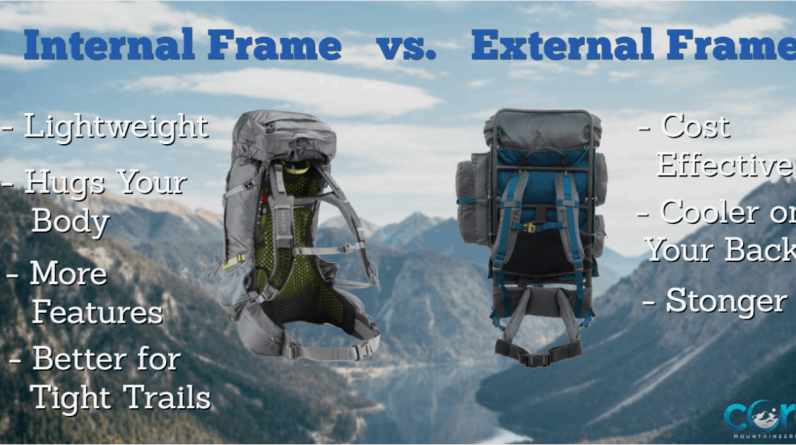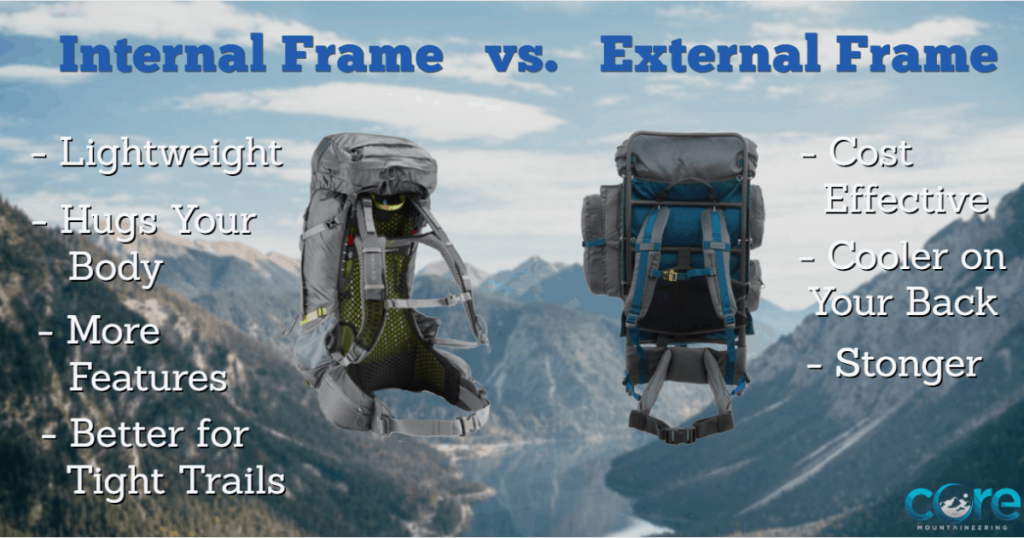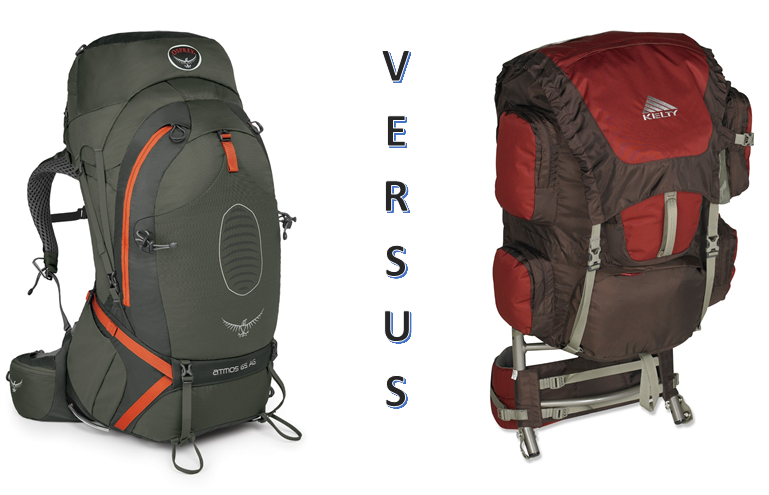
If you’ve ever found yourself pondering the difference between internal frame and external frame backpacks, you’re in the right place! In this article, we’ll break down the key distinctions between these two types of backpacks, helping you understand their unique features and determine the best option for your outdoor adventures. Whether you’re a seasoned hiker or a beginner explorer, understanding the pros and cons of internal frame and external frame backpacks will equip you with the knowledge to make the right choice for your backpacking needs. So, let’s jump right in and discover the world of backpacking frames!

This image is property of coremountaineering.com.
Overview of Internal Frame and External Frame Backpacks
Internal frame backpacks and external frame backpacks are two types of backpacks that have distinct designs and structures. Understanding the difference between these two types of backpacks is important for choosing the right one for your needs and activities. Both types have their own advantages and disadvantages, and it’s crucial to consider factors such as weight distribution, flexibility, stability, suitability for different activities, load capacity, terrain and conditions, ease of use, and price range when making your decision.
Design and Structure
Internal Frame Backpacks
Internal frame backpacks have a design that incorporates a built-in frame within the backpack. This frame is typically made of lightweight materials such as aluminum or carbon fiber. The frame is flexible and molds to the shape of your back, providing a close and comfortable fit. The main compartment of an internal frame backpack is usually accessed through a top-loading or front-loading zipper.
External Frame Backpacks
On the other hand, external frame backpacks have a visible frame that is located outside the main compartment of the backpack. This frame is typically made of durable metal or composite materials. The frame is rigid and keeps the backpack’s weight away from your back, allowing for better ventilation and air circulation. The main compartment of an external frame backpack is usually accessed through a top-loading zipper, and there may be additional pockets and compartments attached to the frame.

This image is property of i.ytimg.com.
Weight Distribution
Internal Frame Backpacks
Internal frame backpacks excel in weight distribution because of their close fit to your body. The built-in frame and snug design help distribute the weight evenly across your hips and shoulders, reducing strain and fatigue. This allows for better balance and maneuverability, especially on rough terrain or during strenuous activities.
External Frame Backpacks
External frame backpacks distribute weight differently compared to internal frame backpacks. The rigid frame of an external frame backpack keeps the weight away from your back, which can be beneficial when carrying heavy loads. The weight is transferred to the frame, which rests on the hips and allows for better balance and stability. However, this design may feel less comfortable and limit your mobility, especially in activities that require frequent bending or twisting.
Flexibility and Versatility
Internal Frame Backpacks
Internal frame backpacks are known for their flexibility and versatility. The close fit of the backpack to your body allows for a wide range of movements, making them suitable for activities that require agility and balance, such as hiking or climbing. The streamlined design also prevents the backpack from snagging on branches or rocks, reducing the risk of accidents or damage to the backpack.
External Frame Backpacks
External frame backpacks, while less flexible than internal frame backpacks, offer their own advantages in terms of flexibility and versatility. The external frame provides attachment points for additional gear, such as tents, sleeping bags, or bulky equipment. This makes them suitable for activities that require carrying a large amount of gear, such as backpacking or hunting. The frame also allows for better organization and accessibility of the items in the backpack.

This image is property of fashionhighschool.net.
Stability and Balance
Internal Frame Backpacks
Internal frame backpacks excel in stability and balance due to their close fit and weight distribution. The snug fit of the backpack to your body reduces shifting or swaying of the load, providing better stability and control. This is particularly important during activities that require balance and agility, such as traversing narrow trails or climbing steep slopes.
External Frame Backpacks
While external frame backpacks may feel less stable due to their design, they offer their own advantages in terms of stability and balance. The rigid frame of the backpack keeps the weight centered and away from your body, allowing for better balance and preventing excessive sway. This can be particularly beneficial when carrying heavy or bulky loads over uneven terrain.
Suitability for Different Activities
Internal Frame Backpacks
Internal frame backpacks are well-suited for a wide range of activities, including hiking, mountaineering, trekking, and backpacking. Their close fit and streamlined design make them ideal for activities that require agility, balance, and freedom of movement. They are particularly well-suited for activities in rugged or narrow terrains where maneuverability is crucial.
External Frame Backpacks
External frame backpacks are best suited for activities that require carrying large amounts of gear or equipment. They are commonly used for backpacking, hunting, or expeditions where the load can be heavy and bulky. The attachment points on the external frame provide ample space for securing additional gear and make these backpacks ideal for extended trips or carrying specialized equipment.

This image is property of fromcitytoforge.files.wordpress.com.
Load Capacity
Internal Frame Backpacks
Internal frame backpacks typically have a lower load capacity compared to external frame backpacks. This is due to the snug fit and streamlined design, which limits the amount of gear or equipment that can be packed. However, internal frame backpacks are designed to prioritize weight distribution and comfort, making them suitable for lighter loads and activities that require agility and mobility.
External Frame Backpacks
External frame backpacks generally have a higher load capacity compared to internal frame backpacks. The rigid frame and attachment points allow for additional gear and equipment to be securely carried. This makes them ideal for carrying heavy or bulky loads over long distances or in remote areas. However, it’s important to note that the weight should still be distributed properly to maintain balance and prevent strain or injury.
Terrain and Conditions
Internal Frame Backpacks
Internal frame backpacks are suitable for a wide range of terrains and conditions. The close fit and flexibility of these backpacks make them adaptable to various environments, whether it’s traversing rugged mountain trails or navigating dense forests. They provide a balance between maneuverability and stability, making them versatile options for different types of outdoor activities.
External Frame Backpacks
Although external frame backpacks may feel less versatile in terms of terrain and conditions, they are particularly well-suited for certain environments. The rigid frame and weight distribution make them suitable for carrying heavy loads over flat or open terrains, such as deserts or tundra. They can also provide better ventilation and air circulation, which can be beneficial in hot or humid conditions.

This image is property of i0.wp.com.
Ease of Use
Internal Frame Backpacks
Internal frame backpacks are generally easier to use compared to external frame backpacks. The streamlined design and accessible compartments make it easy to organize and locate your gear. The close fit and adjustable straps allow for quick and comfortable adjustments on the go. Additionally, the smaller profile of the backpack reduces the risk of the backpack getting caught on obstacles or branches.
External Frame Backpacks
External frame backpacks may require more effort and time to adjust and organize. The external frame and additional gear attachment points add complexity to the design. However, once you become familiar with the setup, external frame backpacks offer convenience in terms of packing and accessing gear. The external frame also allows for easier adjustments and modifications to accommodate different gear or equipment.
Price Range
Internal Frame Backpacks
Internal frame backpacks are available in a wide range of prices, depending on the brand, materials, and features. Basic models can be relatively affordable, making them accessible to budget-conscious adventurers. Mid-range and high-end models with advanced features, such as adjustable suspension systems or lightweight materials, can be more expensive but offer enhanced comfort and performance.
External Frame Backpacks
Similarly, external frame backpacks come in a variety of price ranges. Basic models can be affordable options for those on a budget, especially for individuals who require a higher load capacity. Higher-end models with durable materials, advanced suspension systems, and additional features can be more expensive but provide enhanced durability and comfort.
In conclusion, internal frame and external frame backpacks have their own unique features and advantages. Understanding the distinction between the two is crucial for choosing the backpack that best suits your needs and activities. Factors such as weight distribution, flexibility, stability, suitability for different activities, load capacity, terrain and conditions, ease of use, and price range should all be considered when making your decision. Whether you opt for the close fit and versatility of an internal frame backpack or the additional gear-carrying capacity of an external frame backpack, both types have their place in the world of outdoor adventure.





